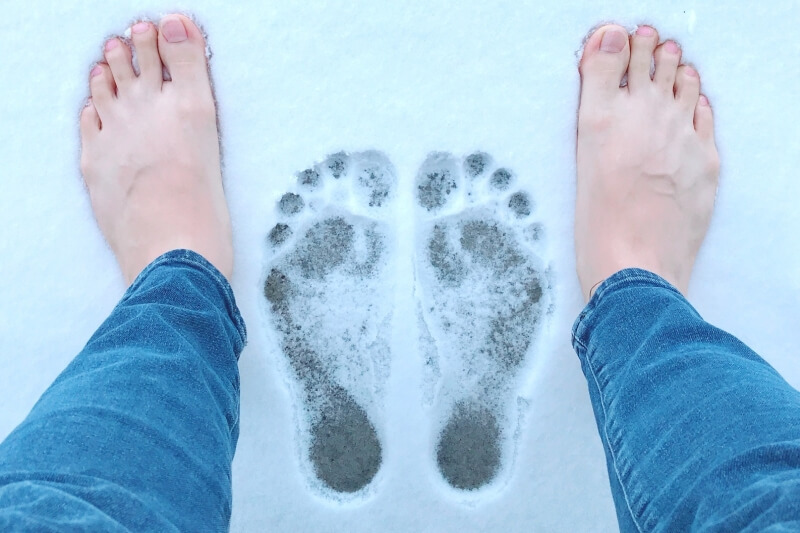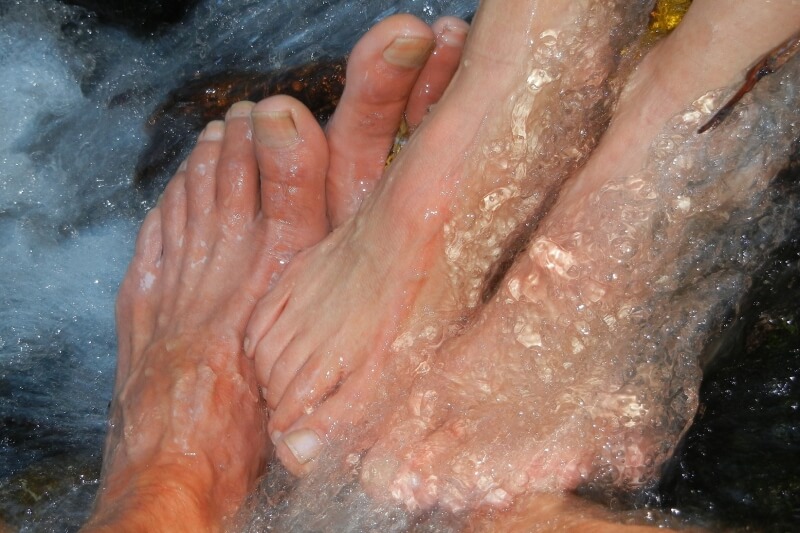Is feet exposure to cold good for your health? How to expose your feet to cold? And how are exposure to cold and barefoot shoes related?
Content of the article
- How does exposure to cold work?
- Benefits of exposure to cold
- How to exposure yourself to cold?
- Preparation of exposure to cold
- When is exposure to cold not recommended?
- Methods of exposure to cold
- Barefoot shoes and exposure to cold
How does exposure to cold work?
Lower temperature stresses the body. If only for a short time and in a low dose, the body learns to cope with stress, toughens up and strengthens immunity. Experts from the Physioclinic describe the body's response to exposure to cold:
Getting used to cold brings goose bumps at first, with the erect hairs forming an insulating layer. The heart races, breathing quickens and muscle tension increases. To protect the internal organs with sufficient blood supply, the body constricts blood vessels in the extremities and face.
If the cold continues, the blood vessels dilate again and try to warm the limbs with more blood flow, but this also causes more heat loss. Increased heat production is also due to muscle contractions, which manifest as involuntary shivering, tremors and teeth grinding.

Just as the body's muscles get stronger with physical exercise, regular and adequate exposure to cold after about 15 days of repetition strengthens cellular immunity. However, there are other positives:
Benefits of exposure to cold
Physiotherapist Hana Žáková from Physio World mentions the benefits of exposure the body to cold and immunity:
- improved blood circulation - increased blood flow and supply of nutrients and oxygen to the tissues
- boosting immunity - increased production of white blood cells and other defensive substances
- improved mood - production of endorphins (happy hormones)
- stress relief - promoting calm and relaxation
- Improving sleep - facilitating falling asleep and improving sleep quality
- Boosting metabolism - improving metabolism and calorie burning
- Improving resilience - adapting to cold environments and temperature fluctuations
How to exposure yourself to cold?
The following main principles apply to :
- Safely - don't overestimate your strength and take risks without supervision, don't get tired or time-sensitive
- Gradually - accustom your body to the cold gradually, do not jump into ice water
- Regularly - expose your body to cold at least twice a week

Preparation for exposure to cold
How to prepare for getting used to cold?
- Prepare warm clothes for warming up before exposure to cold
- Warm only the smaller parts of the body first, then the whole body later
- Breathe - try to breathe in through your nose, taking a deep breath in and an even deeper breath out
- Start with shorter periods and increase the length of time in the cold water
- Gradually lower the ambient temperature
- Stretch and warm your body by moving
When is exposure to cold not recommended?
Despite its many positive effects, getting used to cold is not recommended, for example:
- individuals with heart disease
- people with high blood pressure
- more severe urinary tract and kidney disease
- lung disease
- acute infections and febrile conditions
- pregnant and morbidly obese people
- persons allergic to cold or suffering from claustrophobia
As always, you should consult your doctor about the suitability of accustoming your body to cold. Elevated blood pressure caused by narrowing of blood vessels can be very dangerous, so do not go into exposure to cold without thinking.

Methods of exposure to cold
At the mention of getting used to cold, people most often think of cold showers, extreme people exposing themselves to cold (e.g. in a winter lake) or Wim Hof. However, there are many methods of exposure to cold, from the mildest to the most extreme. For example:
- Accustom yourself to a colder environment - heat less in winter, wear one less layer, etc.
- Switch between warm and cool water - start with warm water and gradually reduce the temperature
- Go barefoot - take off your socks at home, try barefoot outside, not just in summer
- Immerse your feet in a basin of cold water (or a stream) - initially for a quarter of a minute, later for half a minute and extend the intervals
- Take a sauna - alternate high temperatures with cooling
- Try a completely cold shower - practice it in the morning, before breakfast, 1-2 minutes in winter, 3-5 minutes in summer, move around while taking a shower and keep a positive mood
- Follow the Wim Hof method - combine breathing exercises, meditation and cold, but it is recommended to seek certified instructors
- Attend a cryotherapy session - cold air temperatures in the cryochamber drop to -100°C to -160°C, but again, be guided by trained staff
Barefoot shoes and exposure to cold
Thanks to the thin sole, the foot in barefoot shoes is much closer to the surface than in conventional shoes. It therefore feels the cold surface more intensely, especially in the winter months. Purchasing barefoot shoes can be the first step towards getting used to cold, removing the insole is the second step.
At the same time, the foot is actively working in barefoot shoes, so it gets enough blood circulation. So as long as you stay in motion, there is no risk of getting a long-term chill, even in colder temperatures.
Barefoot shoes for kids and adults
